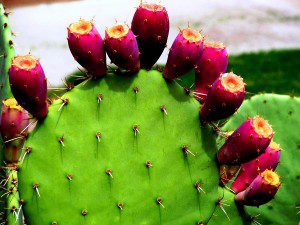Contributing Writer for Wake Up World
If you live in Latin America, or a semi-arid region of the United States, a wild superfood may be ripe for the picking in your own backyard. Known as prickly pear cactus (Opuntia spp), the leaves and fruit of this desert plant can be harvested and consumed to treat a variety of conditions — including diabetes, obesity, cardiovascular disease and inflammation.
Native to the mountainous areas of Mexico, prickly pear cactus has been used since ancient times as a potent medicine, as well as a daily food source. Many of the nutritional advantages of the plant are attributed to its growing habitat – namely, volcanic soil and high altitude. The Aztecs so valued prickly pear that it was considered food fit for warriors and royalty. Jump to the present day and you’ll find health enthusiasts have also embraced the food for boosting stamina, improving health and slimming down.
Health perks
A common sight in Hispanic communities and Latin America, cactus as a food may seem exotic to those unfamiliar with its use. And yet, science is beginning to recognize prickly pear as a beneficial food and therapeutic medicinal for many of the health disorders plaguing us today. One of the more intriguing uses for the cactus paddle (known as nopales) is in the treatment of diabetes. As a low-glycemic, high-fiber food, nopales lowers blood sugar levels, helping to keep obesity and diabetes at bay. Moreover, research published in Chemistry Central Journal found that consuming either tortillas or bars made with nopales increased vitamin C plasma levels, and reduced both cholesterol as well as triglycerides – which is good news for those concerned about cardiovascular disease.
As an added benefit, the plant sterols found in prickly pear act as antioxidants in the system, reducing inflammation and deterring the formation of plaque on blood vessel walls. What’s more, the flavonoids present in the cactus minimize free radical load, which lessens the strain on the liver and boosts overall immunity. Since the fruit and leaves of the plant are loaded with non-carbohydrate polysaccharides in the form of pectin, hemicellulose and mucilage, prickly pear soothes and coats the digestive tract, relieving constipation as well as ulcers.
How to use
Fresh prickly pear nopales and fruit can often be found in your local supermarket – just be cautious about the source as some varieties from Mexico are contaminated with a potent neurotoxic pesticide. Tortillas and fruit bars made from prickly pear are also available. Additionally, organic nopales powder is an easy way to spruce-up your favorite smoothie. If you are lucky enough to have prickly pear cactus growing wild in your neighborhood, have a look at this informative tutorial on how to harvest and juice the fruit.
Sources for this article include:
http://science.naturalnews.com/pubmed
http://hortsci.ashspublications.org/content/25/12/1515.full
http://www.ehow.com/about_5422329_nopales-cactus-health-benefits
http://www.nutrition-and-you.com/nopaleses
Previous articles by Carolanne:
- Common Toxin in Your Pantry Causes Obesity, Diabetes, Infertility… and Much More
- Hemp – The Ultimate Cash Crop, Health Food and Environmental Savior Rolled Into One
-
Europe Embraces Healthy Raw Dairy by Unveiling Fresh Milk Vending Machines
- Confirmed by Science: You Really Can Change Your DNA – Here’s How
-
Chemtrails: Learn How to Protect Yourself From These Treacherous Poisons
- Top 10 Food Frauds: Formaldehyde, Plastic, Melamine & Caustic Soda Found in Common Foods
- Autistic Boy With Higher IQ Than Einstein Discovers Gift After Removal From State-Run Therapy
-
Enhance Spiritual, Mental and Physical Well-being with a Pineal Gland Detox
About the author:
I’m Carolanne — a writer, chef, traveler and enthusiastic advocate for sustainability, organics and joyful living. It’s good to have you here. If you would like to learn more, connect with me at Thrive-Living.net or visit Twitter.com/Thrive_Living.Please note: this article was first published on Natural News.

If you've found value in our articles, we invite you to support the release of our brand-new book, "Gratitude Practices for Kids: A Practical Guide for Adults to Instill a Spirit of Appreciation and Positivity in the Next Generation."
"Gratitude Practices for Kids" brings together over 25 innovative and accessible practices designed to enhance gratitude in everyday life. This comprehensive guide is backed by 17 scientific studies, ensuring each concept is grounded in research, underscoring our commitment to nurturing growth, emotional intelligence, and positive interactions between adults and children.
We encourage you to opt for the paperback version to celebrate this new release. Dive into its fresh pages away from digital distractions, allowing you to immerse yourself in the transformative practices it offers.
Over recent years, Wake Up World has faced significant online censorship, which has impacted our financial ability to operate. Moving into book publishing represents a strategic step to secure the ongoing funds needed to continue our mission. By purchasing Gratitude for Kids, you help us keep our content free and accessible to everyone, avoiding needing a paywall. With over 8,500 articles published in the last 13 years, we remain dedicated to keeping our valuable content open to all.









